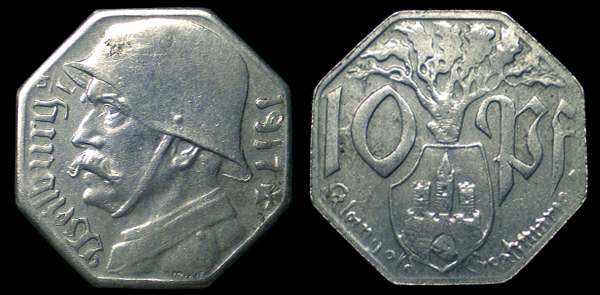
STADT WEILBURG (GERMAN) 10 PFENNIG 1917
L- 564.3 Town of Weilburg (Hesse-Nassau) Iron 10 Pfennig Coin.
This coin was issued during the first world war by the German town of Weilburg. On the obverse is a helmeted soldier, the town name with a/L at the end, the date of issue and a small iron cross. On the reverse is the denomination, an oak tree above the towns coat of arms with the inscription Kleingeld Ersatzmarke (Spare Change).
Weilburg is a picturesque German town in the district of Limburg-Weilburg in Hesse located in the Lahn river valley. It is best known as the the seat of the house of Nassau-Weilburg from 1335 until 1816.
A settlement existed in the area well before it is first mentioned in historical documents. The abbot Regino of Prüm makes mention of the town, known at the time as Wilineburch, in his chronicles written in 906. Development of the town began in earnest under King Conrad I who began work on a a fortified residence (castle), church and an abbey. Conrad died at Weilburg in 918.
Weilburg was passed to the house of Nassau in 1294. Count John I of Nassau-Weilburg made the town his residence in 1355 renovating many of the old buildings and erecting fortifications. A new round of significant renovations and additions to the residence and town were made under John Ernst who transformed the palace into the Renaissance and Baroque influenced castle (schloss) that can be seen today.
Weilburg-Nassau (and the town of Weilburg) was incorporated into the greater Duchy of Nassau under Wilhelm August who relocated to the city of Biebrich in 1817. In 1866 Nassau was incorporated into the Province of Hesse-Nassau when it was annexed by the Kingdom of Prussia. In 1918 Hesse-Nassau became a part of the Free State of Prussia.
Although Weilburg emerged from two world wars relatively unscathed, it suffered the same economic hardships all German cities experienced during and after the first world war. Like most towns and cities Weilburg issued a variety of notgeld. They minted coins in Iron and Zinc to be used as small change as well as series notes.
